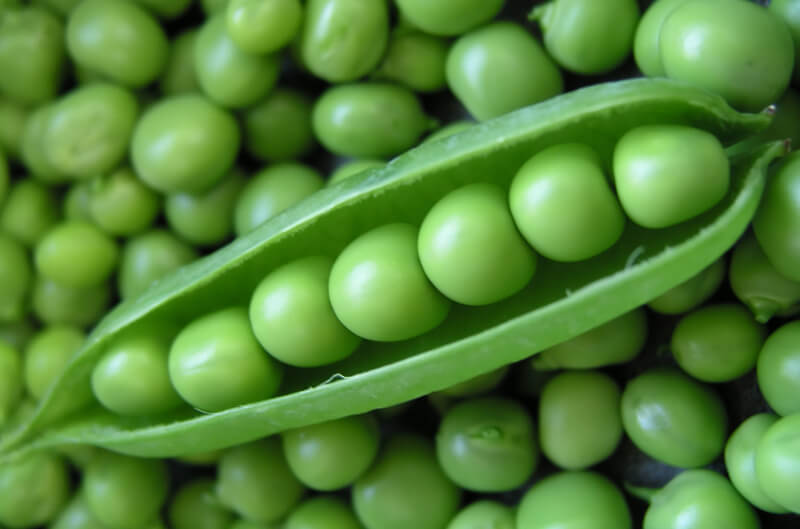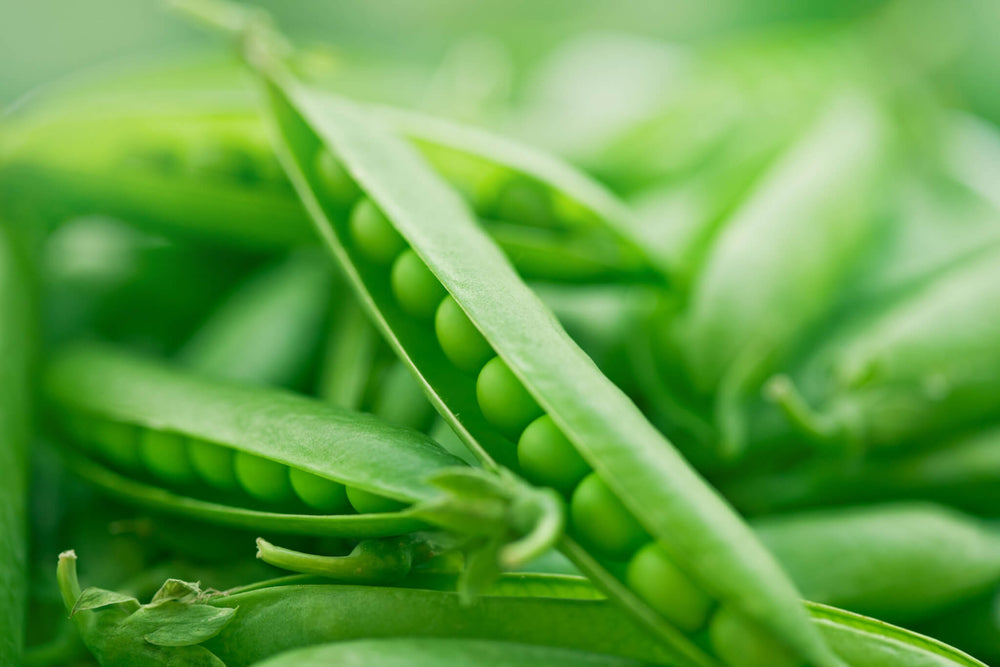There are many reasons for growing green peas. Mouthwatering and tender, homegrown peas are flawless, gracing your meal with vibrant color and delicious flavor. Traditional English peas have sweet, round, green peas inside a pod; you shell the peas and throw away the pod. Another type of pea is the snow pea, the crunchy, flat, sweet pod of Chinese cuisine that is eaten whole; the peas inside are not allowed to get big. However, one pea combines the sweet contents of English peas with the crispy outer pod, or shell, of snow peas. They are called snap-style green peas, and you can eat the whole thing, pod and all, cooked or raw.
To use them as snow peas, harvest really young (before pods fill out); to use them like English peas, let the peas inside get big and then shell them; to eat them as snap peas just crunch down on the whole thing at any stage of growth, and snap! The peas and the pod fill your mouth with a sweet crunch. Snap-style green peas, also called edible podded peas, are the only pea one needs to grow because they are all in one. They also pack a nutritious punch with plenty of iron and vitamin C in every bite. Snap-style Green Pea plants bear small plump pods of round peas on very compact vines.
Quick Guide to Growing Peas
- Plant peas during the mild weather of early spring, once soil temperatures reach 45° F.
- Space young pea plants 5 inches apart in an area with an abundance of sunshine and fertile, well-drained soil.
- Improve your native soil by mixing in several inches of aged compost or other rich organic matter.
- Before planting, stake a tomato cage or trellis in the ground to make harvesting pods easier.
- Lay down a 2-inch layer of straw or dried grass clippings to help retain soil moisture and prevent weeds.
- Ensure your pea plants grow to be strong and vigorous by feeding them regularly with a continuous-release plant food.
- For snap-style peas, harvest when pods begin to flatten.
Soil, Planting, and Care
Peas thrive in cool, damp weather, making them an ideal candidate for early spring planting. In mild climates, you can also plant for a fall harvest, but spring plantings generally yield more. Get peas in the ground as soon as possible in early spring, once the soil temperature reaches at least 45 degrees. Wait to plant until soil is dry enough that it doesn't clump and stick to garden tools, then mix in a layer of aged compost-enriched Miracle-Gro® Performance Organics® All Purpose In-Ground Soil to improve the texture, nutrition, and aeration of your soil. For best results, start with strong young Bonnie Plants® green pea plants, which are already well on their way to maturity. Space plants 5 inches apart.
Young pea plants can take a light frost, so tuck plants into the garden before the last average frost date for your region. However, be prepared to protect flowering plants from a late frost; it will hurt flowers and sometimes causes tiny developing pods to be deformed.
Green peas don't need a trellis, but pods will be easier to pick when vines are held upright. If you're using a trellis, insert it prior to planting. Use netting, stakes, and string, a wood frame trellis covered with chicken wire, metal fencing, or a collection of twiggy branches stuck into the ground among the plants. Peas attach by tendrils, tiny stems that curl and encircle supports. Tendrils quickly wrap around slender supports to hoist vines skyward.
Apply a 2-inch-thick layer of organic mulch, such as straw, grass clippings, or compost, when plants are 6 inches tall. Mulch helps soil retain moisture and suppresses weeds. Keep your pea plot free from weeds, pulling offenders by hand or cultivating very shallowly.
Peas don't need much nitrogen fertilizer, only perhaps a little starter in a new garden or in very poor soil with little organic matter. As members of the legume family, peas actually fix their own nitrogen from the air, and can even improve your soil by adding nitrogen to it. This nitrogen fixing is done in conjunction with rhizobium bacteria, which are probably present in your soil. However, if you have any doubts and want to improve the productivity of peas in the future, you can purchase "inoculant," which is a powder of rhizobium bacteria that you can add to the soil. Once established, the bacteria don't have to be added again. You can also feed plants with Miracle-Gro® Performance Organics® Edibles Plant Nutrition no more than once a month for an extra boost of nutrition.
Withhold water slightly during the early growing phase to encourage deeper rooting (peas tend to be shallowly rooted). Watering is critical from the appearance of the first flower until harvest. Peas need consistent moisture to develop full, flavorful pods.
Troubleshooting
Aphids occasionally attack vines, but can be easily overcome with a douse of insecticidal soap. Peas are susceptible to fusarium wilt and root-rot disease, especially on poorly drained soils. Stunting of the plant, or lower leaves that yellow and wilt, are symptoms of these diseases. Improving soil drainage by adding compost can help prevent outbreaks of these diseases.
To prevent fungal diseases, such as powdery mildew, water peas early in the day so leaves can dry before dusk, or use a soaker hose or drip irrigation so that the foliage doesn't get wet each time you water. Most disease problems can be beaten by planting disease-resistant varieties like Sugar Ann.
Harvest and Storage
Harvest snap-style green peas when pods start to fatten, but before peas get too large. If picked at the right time, the whole pod can be eaten. If pods are chewy and tough, they've been left on vines too long. In this case, shell the peas and compost the pods. Peas will produce as long as vines are healthy and temperatures stay cool. Mulching soil helps keep roots cool. Once the temperature reaches the 80s, pea season is over.
The more you pick peas, the more peas you'll have to pick. After harvest, the sugar in peas turns to starch, decreasing sweetness. For best flavor, cook or freeze peas within a few hours of picking. To freeze snap-style green peas, simply toss pods into plastic freezer bags.
On snap-style pea vines, you can also harvest flowers and leafy shoots for eating. While snap-style green peas are sometimes called sugar snap peas or sweet peas, it's important to note that they are different from the sweet pea vines grown for their ornamental flowers. Those sweet peas are not edible.








 Herbs
Herbs
 Vegetables
Vegetables
 Fruit
Fruit
 Flowers
Flowers
 Succulents
Succulents


